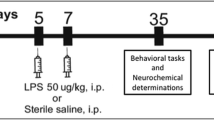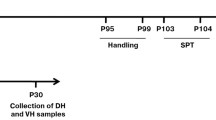Abstract
Neonatal proinflammatory challenge (NPC) may contribute to the development of psychiatric disorders in adults. A double exposure of neonatal rats to lipopolysaccharide, a component of cellular wall of gram-negative bacteria, on postnatal days 3 and 5 provokes the development of depressive- and anxiety-like behaviors. NPC impairs neuroplasticity and cognition in adult animals, significant modifications of neuroplasticity being evident even in adolescence. We studied effects of NPC on microglia and GABAergic neuronal population of the dorsal hippocampus in juvenile male and female rats using immunofluorescent histochemistry. The expression of glutamic acid decarboxylase-67 (GAD67) and calcium-binding proteins calretinin, calbindin, and parvalbumin were used as quantitative markers of GABAergic interneurons and their specific subpopulations, respectively. NPC induced changes of microglial morphology indicating inflammatory activation mostly expressed in CA3 field; the effect was similar in males and females. The number of GAD67 expressing neurons was similar in the dorsal hippocampus of females and males independently on the NPC. The portion of calbindin-immunoreactive GAD67-positive neurons significantly increased while the portion of calretinin-immunoreactive GAD67-positive neurons significantly decreased in the CA1 field of rats exposed to NPC independently on their sex. NPC did not affect the parvalbumin-positive subpopulation of GABAergic neurons in the hippocampus of rats of either sex. These data suggest that NPC-induced modification of GABAergic neuronal population composition under the proinflammatory conditions is involved in the maintenance of excitation/inhibition homeostatic balance in the hippocampus.





Similar content being viewed by others
References
Albrecht A, Müller I, Ardi Z et al (2017) Neurobiological consequences of juvenile stress: a GABAergic perspective on risk and resilience. Neurosci Biobehav Rev 74:21–43. https://doi.org/10.1016/j.neubiorev.2017.01.005
Arnoux I, Audinat E (2015) Fractalkine signaling and microglia functions in the developing brain. Neural Plast 2015:1–8
Baldy C, Fournier S, Boisjoly-Villeneuve S et al (2018) The influence of sex and neonatal stress on medullary microglia in rat pups. Exp Physiol 103:1192–1199. https://doi.org/10.1113/EP087088
Bertling F, Bendix I, Drommelschmidt K et al (2016) Tumor necrosis factor-inducible gene 6 protein: a novel neuroprotective factor against inflammation-induced developmental brain injury. Exp Neurol 279:283–289. https://doi.org/10.1016/j.expneurol.2016.03.005
Bilbo SD, Levkoff LH, Mahoney JH et al (2005) Neonatal infection induces memory impairments following an immune challenge in adulthood. Behav Neurosci 119:293–301. https://doi.org/10.1037/0735-7044.119.1.293
Bilbo SD, Rudy JW, Watkins LR, Maier SF (2006) A behavioural characterization of neonatal infection-facilitated memory impairment in adult rats. Behav Brain Res 169:39–47. https://doi.org/10.1016/j.bbr.2005.12.002
Bland ST, Beckley JT, Watkins LR et al (2010) Neonatal Escherichia coli infection alters glial, cytokine, and neuronal gene expression in response to acute amphetamine in adolescent rats. Neurosci Lett 474:52–57. https://doi.org/10.1016/j.neulet.2010.03.006
Bordt EA, Ceasrine AM, Bilbo SD (2020) Microglia and sexual differentiation of the developing brain: a focus on ontogeny and intrinsic factors. Glia 68:1085–1099. https://doi.org/10.1002/glia.23753
Braun K, Seidel K, Weigel S et al (2011) Paternal deprivation alters region- and age-specific interneuron expression patterns in the biparental rodent, Octodon degus. Cereb Cortex 21:1532–1546. https://doi.org/10.1093/cercor/bhq208
Claypoole LD, Zimmerberg B, Williamson LL (2017) Neonatal lipopolysaccharide treatment alters hippocampal neuroinflammation, microglia morphology and anxiety-like behavior in rats selectively bred for an infantile trait. Brain Behav Immun 59:135–146. https://doi.org/10.1016/j.bbi.2016.08.017
Czéh B, Varga ZKK, Henningsen K et al (2015) Chronic stress reduces the number of GABAergic interneurons in the adult rat hippocampus, dorsal–ventral and region-specific differences. Hippocampus 25:393–405. https://doi.org/10.1002/hipo.22382
Dupuy ST, Houser CR (1997) Developmental changes in GABA neurons of the rat dentate gyrus: an in situ hybridization and birthdating study. J Comp Neurol 389:402–418
Dupuy ST, Houser CR (1996) Prominent expression of two forms of glutamate decarboxylase in the embryonic and early postnatal rat hippocampal formation. J Neurosci 16:6919–6932. https://doi.org/10.1523/jneurosci.16-21-06919.1996
Falck M, Osredkar D, Wood TR et al (2018) Neonatal systemic inflammation induces inflammatory reactions and brain apoptosis in a pathogen-specific manner. Neonatology 113:212–220. https://doi.org/10.1159/000481980
Fernández-Arjona MDM, Grondona JM, Granados-Durán P et al (2017) Microglia morphological categorization in a rat model of neuroinflammation by hierarchical cluster and principal components analysis. Front Cell Neurosci 11:235. https://doi.org/10.3389/fncel.2017.00235
Gulyás AI, Hájos N, Freund TF (1996) Interneurons containing calretinin are specialized to control other interneurons in the rat hippocampus. J Neurosci 16:3397–3411. https://doi.org/10.1523/jneurosci.16-10-03397.1996
Harré EM, Galic MA, Mouihate A et al (2008) Neonatal inflammation produces selective behavioural deficits and alters N-methyl-d-aspartate receptor subunit mRNA in the adult rat brain. Eur J Neurosci 27:644–653. https://doi.org/10.1111/j.1460-9568.2008.06031.x
Holland FH, Ganguly P, Potter DN et al (2014) Early life stress disrupts social behavior and prefrontal cortex parvalbumin interneurons at an earlier time-point in females than in males. Neurosci Lett 566:131–136. https://doi.org/10.1016/j.neulet.2014.02.023
Karperien A, Ahammer H, Jelinek HF (2013) Quantitating the subtleties of microglial morphology with fractal analysis. Front Cell Neurosci 7:1–34
Khazipov R, Zaynutdinova D, Ogievetsky E et al (2015) Atlas of the postnatal rat brain in stereotaxic coordinates. Front Neuroanat 9:161. https://doi.org/10.3389/fnana.2015.00161
Kohman RA, Tarr AJ, Sparkman NL et al (2008) Neonatal endotoxin exposure impairs avoidance learning and attenuates endotoxin-induced sickness behavior and central IL-1β gene transcription in adulthood. Behav Brain Res 194:25–31. https://doi.org/10.1016/J.BBR.2008.06.018
Kudryashova IV, Stepanichev MYu, Gulyaeva NV (2019a) Neonatal stress and maturation of intercellular communication in the hippocampus. Zhurnal Vyss Nervn Deyatelnosti Im IP Pavlov 69:680–699. https://doi.org/10.1134/S0044467719060078
Kudryashova IV, Tishkina AO, Gulyaeva NV (2019b) Neonatal proinflammatory stress and deficit of induction of long-term potentiation in the hippocampus in rats: gender differences. Neurosci Behav Physiol 49:1118–1126. https://doi.org/10.1007/s11055-019-00848-3
Lenz KM, Nelson LH (2018) Microglia and beyond: Innate immune cells as regulators of brain development and behavioral function. Front Immunol. 9:698
Livak KJ, Schmittgen TD (2001) Analysis of relative gene expression data using real-time quantitative PCR and the 2-ΔΔCT method. Methods 25:402–408. https://doi.org/10.1006/meth.2001.1262
Martianova E, Aniol VA, Manolova AO et al (2019) Activation of microglia associated with lentiviral transduction: a semiautomated method of assessment. Acta Histochem 121:368–375. https://doi.org/10.1016/j.acthis.2019.01.008
McCarthy MM, Wright CL (2017) Convergence of sex differences and the neuroimmune system in autism spectrum disorder. Biol Psychiatry 81:402–410
Miettinen R, Gulyás AI, Baimbridge KG et al (1992) Calretinin is present in non-pyramidal cells of the rat hippocampus–II. Co-existence with other calcium binding proteins and GABA. Neuroscience 48:29–43. https://doi.org/10.1016/0306-4522(92)90335-y
Morrison H, Young K, Qureshi M et al (2017) Quantitative microglia analyses reveal diverse morphologic responses in the rat cortex after diffuse brain injury. Sci Rep 7:1–12. https://doi.org/10.1038/s41598-017-13581-z
Mukherjee R, McQuinn TC, Dugan MA et al (2010) Cardiac function and circulating cytokines after endotoxin exposure in neonatal mice. Pediatr Res 68:381–386. https://doi.org/10.1203/PDR.0b013e3181efbe10
Notter T, Panzanelli P, Pfister S et al (2014) A protocol for concurrent high-quality immunohistochemical and biochemical analyses in adult mouse central nervous system. Eur J Neurosci 39:165–175. https://doi.org/10.1111/ejn.12447
Onufriev MV, Freiman SV, Peregud DI et al (2017) Neonatal proinflammatory stress induces accumulation of corticosterone and interleukin-6 in the hippocampus of juvenile rats: potential mechanism of synaptic plasticity impairments. Biochemistry 82:275–281. https://doi.org/10.1134/S0006297917030051
Orłowski D, Sołtys Z, Janeczko K (2003) Morphological development of microglia in the postnatal rat brain: a quantitative study. Int J Dev Neurosci 21:445–450. https://doi.org/10.1016/j.ijdevneu.2003.09.001
Rideau Batista Novais A, Crouzin N, Cavalier M et al (2014) Tiagabine improves hippocampal long-term depression in rat pups subjected to prenatal inflammation. PLoS ONE 9:e106302. https://doi.org/10.1371/journal.pone.0106302
Schwartzkroin PA, Scharfman HE, Sloviter RS (1990) Chapter 20 Similarities in circuitry between Ammon’s horn and dentate gyrus: local interactions and parallel processing. Prog Brain Res 83:269–286. https://doi.org/10.1016/S0079-6123(08)61256-X
Schwarz JM, Bilbo SD (2011) LPS elicits a much larger and broader inflammatory response than Escherichia coli infection within the hippocampus of neonatal rats. Neurosci Lett 497:110–115. https://doi.org/10.1016/j.neulet.2011.04.042
Seidel K, Helmeke C, Poeggel G, Braun K (2008) Repeated neonatal separation stress alters the composition of neurochemically characterized interneuron subpopulations in the rodent dentate gyrus and basolateral amygdala. Dev Neurobiol 68:1137–1152. https://doi.org/10.1002/dneu.20651
Shanks N, Larocque S, Meaney MJ (1995) Neonatal endotoxin exposure alters the development of the hypothalamic–pituitary–adrenal axis: early illness and later responsivity to stress. J Neurosci 15:376–384
Shanks N, Windle RJ, Perks PA et al (2000) Early-life exposure to endotoxin alters hypothalamic–pituitary–adrenal function and predisposition to inflammation. Proc Natl Acad Sci USA 97:5645–5650. https://doi.org/10.1073/pnas.090571897
Tishkina A, Stepanichev M, Kudryashova I et al (2016) Neonatal proinflammatory challenge in male Wistar rats: effects on behavior, synaptic plasticity, and adrenocortical stress response. Behav Brain Res 304:1–10. https://doi.org/10.1016/j.bbr.2016.02.001
Uchida T, Furukawa T, Iwata S et al (2014) Selective loss of parvalbumin-positive GABAergic interneurons in the cerebral cortex of maternally stressed Gad1-heterozygous mouse offspring. Transl Psychiatry 4:e371. https://doi.org/10.1038/tp.2014.13
Weinhard L, Neniskyte U, Vadisiute A et al (2018) Sexual dimorphism of microglia and synapses during mouse postnatal development. Dev Neurobiol 78:618–626. https://doi.org/10.1002/dneu.22568
Williamson LL, Bilbo SD (2014) Neonatal infection modulates behavioral flexibility and hippocampal activation on a Morris Water Maze task. Physiol Behav 129:152–159. https://doi.org/10.1016/j.physbeh.2014.02.033
Xu J, Ling EA (1994) Upregulation and induction of surface antigens with special reference to MHC class II expression in microglia in postnatal rat brain following intravenous or intraperitoneal injections of lipopolysaccharide. J Anat 184(Pt 2):285–296
Xu X, Roby KD, Callaway EM (2010) Immunochemical characterization of inhibitory mouse cortical neurons: three chemically distinct classes of inhibitory cells. J Comp Neurol 518:389–404. https://doi.org/10.1002/cne.22229
Yokochi T, Inoue Y, Yokoo J et al (1989) Retention of bacterial lipopolysaccharide at the site of subcutaneous injection. Infect Immun 57:1786–1791
Young K, Morrison H (2018) Quantifying microglia morphology from photomicrographs of immunohistochemistry prepared tissue using ImageJ. J Vis Exp 2018:e57648. https://doi.org/10.3791/57648
Funding
This study was supported by the Russian Science Foundation (project #19-75-00063).
Author information
Authors and Affiliations
Contributions
M. Stepanichev and N. Gulyaeva planned the experiments, conceptualized the data, analyzed the data, and wrote the manuscript. T. Goryakina, N. Lazareva, and A. Manolova performed immunnohistochemistry, fluorescent microscopy, image analysis, cell counting, and formal analysis. M. Stepanichev, A. Kvichansky, and A. Manolova performed experiments with animals. A. Kvichansky, L. Tretyakova, and M. Volobueva performed PCR analysis. A. Manolova funding acquisition.
Corresponding author
Ethics declarations
Conflict of interest
The authors declare no conflict of interest.
Availability of data and material
All raw data are available on demand.
Ethics approval
This article does not contain any studies with human participants performed by any of the authors. All applicable international, national, and/or institutional guidelines for the care and use of animals were followed. All procedures performed in studies involving animals were in accordance with the ethical standards of the institution or practice at which the studies were conducted. Experiments were performed in accordance with the principles of Basel declaration and Directive 2010/63/EU of the European Parliament and of the Council of 22 September 2010 on the protection of animals used for scientific purposes, and the Order of the Ministry of Health Care of the Russian Federation no. 199n, April 1, 2016 “On approval of the rules of good laboratory practice”, and were supervised by the Ethical Commission of the Institute of Higher Nervous Activity and Neurophysiology, Russian Academy of Sciences, Moscow, Russia.
Consent for publication
All authors approved the manuscript.
Additional information
Publisher's Note
Springer Nature remains neutral with regard to jurisdictional claims in published maps and institutional affiliations.
Supplementary Information
Below is the link to the electronic supplementary material.
Rights and permissions
About this article
Cite this article
Stepanichev, M.Y., Goryakina, T., Manolova, A. et al. Neonatal proinflammatory challenge evokes a microglial response and affects the ratio between subtypes of GABAergic interneurons in the hippocampus of juvenile rats: sex-dependent and sex-independent effects. Brain Struct Funct 226, 563–574 (2021). https://doi.org/10.1007/s00429-020-02199-z
Received:
Accepted:
Published:
Issue Date:
DOI: https://doi.org/10.1007/s00429-020-02199-z




